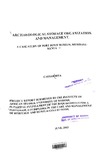| dc.contributor.author | Bita, Caesar | |
| dc.date.accessioned | 2013-06-28T10:14:44Z | |
| dc.date.available | 2013-06-28T10:14:44Z | |
| dc.date.issued | 2003 | |
| dc.identifier.citation | Postgraduate diploma in the care and management of heritage and museum collections | en |
| dc.identifier.uri | http://erepository.uonbi.ac.ke:8080/xmlui/handle/123456789/41702 | |
| dc.description.abstract | This report presents a study done in the Fort Jesus museum on the archaeological storage
organization and management and how this is likely to lead to deterioration of collections.
The research sought to answer the question whether poor storage organization is likely to
lead to the deterioration of archaeological objects at the museum. Its main objective was to
study the store and come up with qualitative information concerning the facility and also
information on what should be done to mitigate damage to the objects. The study was based
on published data as well as observations made by the author himself Relevant data was
collected in photographs and tables. Instruments used for the data collections and
throughout the study included among others thermohygrographs, cameras, scanners and the
like. Collected data has been descriptively analyzed by comparatively looking at the
standard practice in published literature and the level at which Fort Jesus museum is
operating then asking whether it is at the standard practice or below. From this basis,
guidelines and recommendations have been drawn. Nevertheless, results gathered revealed
that stored objects are likely to deteriorate at Fort Jesus Museum due to both poor storage
organization and management. To project these collections to the future, the study has
recommended that sustained effort should be made to improve conditions in the storage
facilities. On the same level, a number of proposals for further action have been offered
among these being the need to draft collection care and management policies for Fort Jesus
museum and training of staff in basic collection management and care. All in all to achieve
optimum preservation of collections, the study observed that there is need for renewal of
the commitment by the museum itself to the care of its collections because this is the first
step if these collections are to preserve for the present and future generations. | en |
| dc.language.iso | en | en |
| dc.publisher | University of Nairobi, | |
| dc.title | Archaeological Storage Organization and Management. A Case Study of Fort Jesus Museum, Mombasa Kenya | en |
| dc.type | Thesis | en |
| local.publisher | Institute Of Anthropology, Gender And African Studies, University of Nairobi | en |

